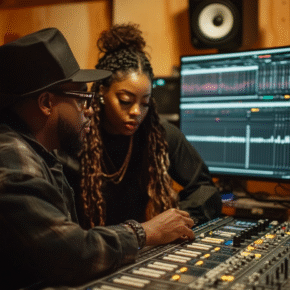In music production, dynamics in music are essential for crafting a great mix. Dynamics refer to the variation in volume, intensity, and energy within a track. They create emotional depth and keep listeners engaged by adding contrast and movement. Without dynamics, even the best compositions can feel flat and lifeless. Let’s dive into how dynamics elevate your music and why they’re a crucial element in mixing.
What Are Dynamics in Music?
Definition of Dynamics
Dynamics in music refer to changes in volume and intensity. They dictate how loud or soft a piece of music is and how it transitions between these extremes.
Types of Dynamics
- Microdynamics: Variations within a single instrument or vocal performance.
- Macrodynamics: The overall shifts in loudness throughout an entire track or song.
Why Dynamics Are Important in Music
Creating Emotional Impact
Dynamics breathe life into music by evoking emotions. A quiet verse followed by a powerful chorus can create tension and release, connecting deeply with listeners.
Enhancing Listener Engagement
Tracks with dynamic variation keep listeners interested. Without dynamics, songs can feel repetitive and monotonous.
Defining Musical Identity
Dynamics help convey the mood and character of a track. A gentle acoustic ballad has a different dynamic range than a high-energy dance track, and both rely on dynamics to define their identity.

How Dynamics Contribute to a Great Mix
Balancing Elements
Dynamics ensure that every element in a mix has its space. For instance, compressing vocals too much can flatten their emotional delivery, while balancing dynamics keeps them expressive.
Creating Contrast
Contrast between quiet and loud sections enhances the emotional journey of a song. A dynamic mix builds anticipation and makes impactful moments stand out.
Improving Clarity
Dynamics help prevent overcrowding in a mix. Proper control ensures that no single element overpowers others, resulting in a cleaner, more professional sound.
Techniques for Controlling Dynamics in Music
Compression and Limiting
Compression controls peaks and balances loudness, while limiting ensures tracks don’t clip or distort.
Automation
Volume automation allows you to adjust dynamics throughout the track, emphasizing key moments like choruses or breakdowns.
Layering and Panning
Layering instruments and panning them across the stereo field creates dynamic depth and movement.
Use of Effects
Reverb and delay can add subtle dynamics, creating a sense of space and dimension in a track.
Transform your next hit?
Common Mistakes with Dynamics
Overcompression
Applying too much compression can strip a track of its natural dynamics, making it sound flat and lifeless.
Lack of Contrast
Tracks that stay at the same volume level lack emotional impact. Introducing contrast is key to keeping listeners engaged.
Neglecting Automation
Failing to use automation can result in static, uninteresting tracks. Dynamics need to evolve throughout a song to maintain interest.
FAQs About Dynamics in Music
What are dynamics in music?
They refer to the variations in volume and intensity within a track or song.
Why are dynamics important in mixing?
Dynamics add emotion, contrast, and clarity to your mix, making it more engaging and impactful.
How can I improve dynamics in my tracks?
Use tools like compression, automation, and effects to control and enhance dynamics.
What happens if I overcompress my track?
Overcompression flattens dynamics, making the track sound lifeless and less engaging.
Can dynamics be fixed during mastering?
Mastering can enhance dynamics, but a well-mixed track with proper dynamics is essential for the best results.
Conclusion
Dynamics in music are the heartbeat of a great mix. They create emotion, enhance engagement, and bring your tracks to life. By understanding and controlling dynamics, you can craft music that resonates deeply with listeners. Whether you’re balancing a quiet verse with a loud chorus or adding subtle variations within an instrument, dynamics are key to a professional, impactful sound.





